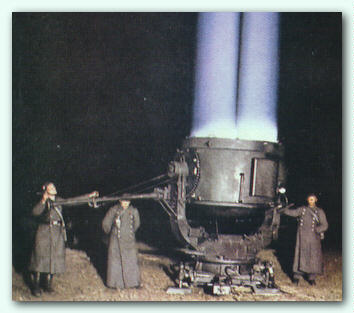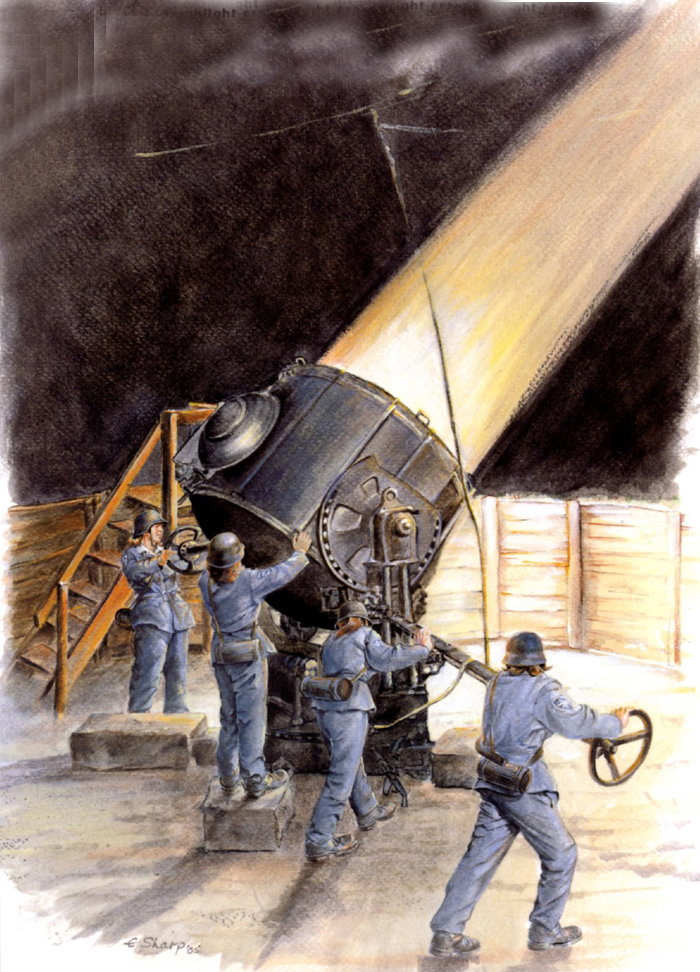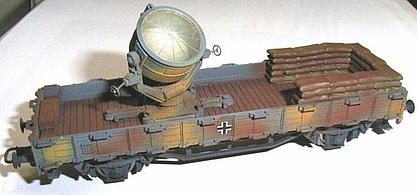


Projecteur 150cm Sw.37
English Translation
Historique Voir ICI
History Click HERE
SCHEINWERFER 110 cm, 150 cm, 200 cm
Projecteurs 110 cm, 150 cm, 200 cm
Les Allemands ont utilisés des projecteurs contre avion déjà en avant la 1° Guerre Mondiale car un
avion ennemi représente un danger pour les Etat Majors. Un premier exercice avec des focales de 60 cm et 90 cm a eu lieu à la forteresse de Feldund et un autre exercice avec emploi combiné de Projecteur et de canon Flak a eu lieu à Coblence en 1913. Mais la vitesse et l'altitude des nouveaux avions forcent les allemands à mettre au point des projecteurs plus puissants. Si au début de la 1° Guerre Mondiale les projecteurs étaient assez puissants, ils deviennent rapidement obsolètes
En fait, peu après le début de la guerre ,des attaques aériennes sont effectuées par des avions rapide la nuit sur le territoire allemand contre des centres militaires
Si le feu de la défense DCA est efficace le projecteur est utile la nuit Aussi pour avoir un projecteur puissant l’ Etat Major se tourne en 1 916, vers la Kriegmarine
La Kriegmarine utilise pour la défense Côtière des projecteurs de 110 cm et 200 cm ou FIakscheinwerfer.
Un socle permet une rotation de 360 ° en azimut et 90 ° en site Ce projecteur est mis en œuvre par un seul homme
Le projecteur de 110 cm a porte jusqu’à environ 4000 m, alors que le projecteur de 200 cm porte jusqu’à environ 5500 m
Après une étude par un inspecteur de la Flakwaffen les projecteurs sont considérés comme parfaits pour un usage terrestre
Pour utiliser ce matériel, il est nécessaire de disposer d'un générateur Donc il a été adapté un moteur à quatre cylindres de 30 CV, une dynamo avec une puissance de 16,5 kW et 165 Ampères
L’ attelage de Projecteur t (Lafettenscheinwerfer) a été tiré par des chevaux et ensuite par des camions t
Il était composé d'une remorque avec les machines (vierspannigen wagon) et 2 zweispannigen Geratewagen, 3 tonnes porte projecteur des camions de transport de 3 tonnes et de remorques avec les accessoires
Les 200 mm sont montés ainsi que les 250 et 465 mm sur des wagons
À la naissance de la Wehrmacht allemande en 1935, certains Projecteurs de la Reichswehr de 110 cm sont toujours utilisé
Rapidement il est mis au point un projecteur léger de 60 mm et un lourd de150 ms.
Ils sont très mobiles grâce à Sonderanhanger Sd.Ah. 104 équipé d'une double suspension
Avec un temps moyen les projecteurs Sw. De 050mm portent à environ 10000 m en horizontal et 12000 m en vertical. Une amélioration de 150 mm Flakscheinwerfer avec des lampes 37 Besa permet d’ atteindre une distance d'environ 12000 m à l'horizontale et 15000 m en vertical.
Les deux types ont été équipés de cette lampe d’une optique en verre plat de 150 cm de diamètre de 650 m de longueur focale Les 150 cm Sw.34 Ont une puissance de 1100 millions de bougies (ou Hefnerkerzen HK) et ceux de 150mm Sw. 37 atteignent environ 1200 millions de bougies (ou Hefnerkerzen HK).
Le générateur
Le Projecteur est relié par l'intermédiaire de deux câbles en caoutchouc chaque 200 mètres long, à un generateure (fahrbare Maschinensatz 33 ou 37) d’une puissance d'environ 24 kW. Les 200 mm, ont besoin de 2 Sonderanhanger 206 avec une puissance de 120 kW chacun avec 450 ampères à 110 v2lts généré par un Masthinensatz de 60 kW
Au début de la 2° Guerre Mondiale une unité des composée de 9 Flakscheinwerfern 34 ou 37 ,d’un Dunkelsuchgerat 41 et neuf dispositifs d'écoute (Richtungshorern)
Le Projecteur est surtout utilisé par nuit claire, car le radar prend peut à peu le relais avec plus de précision.
SCHEINWERFER 110 cm, 150 cm, 200 cm
Searchlight 110 cm, 150 cm, 200 cm
A use of searchlight by German Army to found aircraft was already before WW1 because the figth against hostile airships was a priority problem for Headquarter. A first exercise with searchlight with 60 cm and 90 cm took place in Feldund Fortress and after searchlight together with Flak was held at Koblenz in 1913 .But the speed and the altitude of new aircrafts force German Army to search new searchlight more powerful. If at the beginning of WW1 searchlight are enough powerful quickly they become obsolete
In fact little after the beginning of the war, hostile become air attacks by faster aircraft at night on Front and over barracks in home areas.
If an effective defensive fire was provided by the Flak the use of the searchlight was useful by night
So to have a powerful searchlight in 1916 it was ask to Kriegmarine
The Kriegmarine an Costal defense use 110 cm and 200cm searchlight or FIakscheinwerfer .
A pedestal allowed rotation around 360 °in azimuth and 90° in angle of sigth This searchlight. Could be use by only one man
The range of 110 cm Sw searchlight was approximately of 4,000 m even though the range of the 200 cm Sw. was around 5,500 m After observation by the inspector of the Flakwaffen this searchlight were perfect for the land use
To use this material it was necessary to have a generator So a 4 cylinder engine of 30 horsepower, a DC dynamo with an output of 16.5 kW and 165 amps
The team with searchlight( Lafettenscheinwerfer ) was pulled by horses and after by trucks
It was composed of a trailor with machinery (vierspannigen wagon) and 2 zweispannigen Geratewagen, 3-ton transport trucks headlights and the 3-ton machines wagon with complements
The 200 cm Sw until the end of the war was on railway like the 465 Sw. and 25 Sw. searchlight
At the birth of the German Wehrmacht in 1935 some of the Reichswehr 110 cm searchlight were alway used
Quickly newly 60 cm Sw. and a 150 cm Sw.34 searchlight.were developed The first for Ligth Flak and the second for heavy Flak.They were mobile thanks to Sonderanhanger by little after they were put on a trailor Sd.Ah. 104 equipped with a the double suspension
By medium weather the range of the 150 cm Sw.was approximately 10,000 m in horizontal and 12,000 m in vertical. A improved 150 cm Flakscheinwerfer with a 37 Besa lamp reach a distance of approximately 12,000 m in the horizontal and 15,000 m in vertical. Both types were equipped with this lamp. a glass-dish of 150 cm of diameter a 650 m focal length.. A A 150 cm Sw.34 as a power of 1,100 million candles(Hefnerkerzen or HK) and 150 cm Sw. 37 approximately 1,200 million candles (Hefnerkerzen or HK).
A powerunit source send electric powered
The searchlight were connected via two rubber hoses each 200 meters long, to mobile power units (fahrbare Maschinensatz 33 oder 37 ) with 200 Amp, 110 V, approximately 24 kW,. The 200 cm- Sw.,use 2 Sonderanhanger 206 with a power of 120 kW each He required electricity with 450 amps at 110 volts generated by a Masthinensatz of 60 kW
At the outbreak of WWar 2 a unit was strong of 9 Flakscheinwerfern 34 or 37 and the Dunkelsuchgerat 41 Ring and nine listening devices ( Richtungshorern)
The searlights were use only by clear night, . little the radar take over to sear the night fighter with more accuracy.
 |
Autres Photoscopes (Other Walk Around )
Projecteur 150cm Flakscheinwerfer Flak-Sw 37
Projecteur 150cm Sw.37
Projecteur 150cm Sw.37 Auddhingen
Projecteur 60cm Bruxelles
Projecteur 60cm Bruxelles
Projecteur 60cm Flakscheinwerfer Flak-Sw 36 60cm Stromaggregat
Anglais
90 cm Searchlight
90cm Searchligth
90cm Searchligth Lisbonne
90cm Searchligth Hendon
90cm Searchligth Rimini
USA
Searchlight 60 pouces 1942
Searchlight 60 pouces 1942 Overloon
Searchlight 60 pouces 1942 Viervilles
Searchligth 60 pouces 1942
 |
| Internet |
Voir Aussi Autre Photoscope See Also Other Walk Around
Générateur 24KVA sur remorque Sd Anh 104 1 2 3
Projecteur de 60cm 1 2
 |
| Internet |